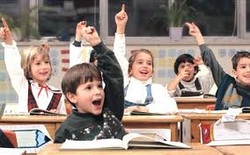
With the invention of the internet and social networking, cultural events and ideas are digitized, transported, and disseminated instantaneously around the world with lightning speed. These cultural events and ideas impact everyone, from the types of cars people drive, to the types of foods they eat. Today, we live in a global village (Merriman and Nicoletti, 2008), and our education system is increasingly becoming more sensitive to the differences in cultures around the world. According to the National Center for Education Statistics (2010), already in the nation’s largest 60 school districts, the population is more than 75% non-white with no single ethnic group comprising more than 40% of the school population; and nationally our schools are already almost 45% non-white. Morrell & Morrell (2012) points out that early childhood education professionals not only have to account for racial and ethnic diversity, but also religious diversity, socioeconomic diversity, diversity of family and home life, and diversity in language and country of origin-to name a few. Noddings (2003) believes education nurtures a depth of being and flourishing of human spirit. It helps individuals to realize their full potential and also to become productive members of their communities, contributing citizens of a nation, and responsible citizens of the world (Suh & Samuel, 2011). Some researchers argue that in order for students to stay competitive in the 21st century, we must not stunt their growth by giving them a mono-cultural education, but we must nurture them and promote multicultural education (Suh & Samuel, 2011). Promoting multicultural education within schools helps expose students to the many cultures they could possibly encounter as working adults. The purpose of this analysis is to explore multicultural literature and its effectiveness within the classroom setting. Also, this analysis will address multicultural themes and trends within education. Lastly, this analysis will supply a list of multicultural materials and a vendor contact list located in the appendix.
Gorski (2001) defines multicultural education is defined as a progressive approach for transforming education that holistically critiques and addresses current shortcomings, failings, and discriminatory practices in education. It is grounded in the ideals of social justice, education equity, and a dedication to facilitating educational experiences in which all students reach their full potential as learners and as socially aware and active beings, locally, nationally, and globally (p.1). Gorski (2001) additionally says multicultural education acknowledges that schools are essential to laying the foundation for the transformation of society and the elimination of oppression and injustice. Banks (1993) explains multicultural education in a broader sense: "Multicultural education is an idea stating that all students, regardless of the groups to which they belong, such as those related to gender, ethnicity, race, culture, social class, religion or exceptionality, should experience educational equality in the schools" (p. 25). Both definitions are based on ethical principles such as justice and care. According to Suh & Samuel (2011) from the sensibility of justice and care emanates respect for diversity, equality, rights and responsibility, concern for other human beings and their points of view, and other democratic values. Multicultural education eliminates stereotyping and avoids negative attitudes towards other groups, and it also helps students to develop a more positive attitude towards other cultures and nations.
One way to teach students respect for diversity and cultural pluralism is through the use of children’s literature. Children can be taught basic values such as: honesty, respect, care for others, responsibility, and respecting the rights of others, through a careful selection of well chosen books that reflect our societal values. However, Madigan (1993) states that multicultural literature is hard to define since it includes the literary writing of groups of people from different races, colors, values, and cultures. It is often labeled as literature of minority cultures that emphasize respect for the different historical perspectives and cultures in human society (p.169). Cai (2002) furthermore asserts that multicultural literature “involves diversity and inclusion, but more importantly, it also involves power structure and struggle. Its goal is not just to understand, accept, and appreciate cultural differences, but also to ultimately transform the existing social order in order to ensure greater voice and authority to the marginalized cultures and to achieve social equality and justice among all (p.7)”. Suh and Traiger (2000) cite four basic approaches in which multicultural children’s literature can be utilized:
There are a variety of ways early childhood professionals can incorporate multicultural themes into their lessons. Morrison (2007) offers the following suggested themes to help children identify cultural similarities and encourage understanding and tolerance: “getting to know myself, getting to know others; what is special about you and me; growing up in the city; tell me about your country of origin (p.434)”. In addition to incorporating multicultural themes into lessons, early childhood professionals can also add the accomplishments of people from different cultural groups, women of all cultures, and individuals with disabilities. Morrison (2007) also suggests the following criteria as being the most important when picking materials for use in a multicultural curriculum for early childhood programs:
“Represent people of all cultures fairly and accurately. Represent people of color, many cultural groups, and people with exceptionalities. Be sure that historic information is accurate and nondiscriminatory. Be sure that materials do not include stereotypical roles or language. Ensure gender equity-that is, boys and girls must be represented equally and in non-stereotypical roles (p.434)”.
Promoting an anti-bias curriculum will help children to learn to be accepting of others, regardless of race, ethnicity, gender, sexual orientation, socioeconomic status, or disability; and it will help them become more comfortable with diversity and learn to stand up for themselves and others in the face of injustice (Morrison, 2007, p.436).
References
Banks, J.A. (1993). Multiethnic education: Theory and practice (3rd ed.). Boston: Allyn & Bacon.
Bista, K. (2012). Multicultural Literature for Children and Young Adults. Educational Forum, 76(3), 317-325.
Cai, M. (2002). Multicultural literature for children and young adults: Reflections on critical issues. Westport, CT: Greenwood.
Gorski, P.C. (2001). Mission and purpose. St. Paul, MN: EdChange Multicultural Pavillion
Hoge, J. (1996). Effective Elementary Social Studies. Belmont: Wadsworth Publishing Co.
Huber, L.K. (2000). Promoting cultural awareness through dramatic play centers. Early Childhood Education Journal, 27(4), 235-238.
Madigan, D. 1993. The politics of multicultural literature for children and adolescents: Combining perspectives and conversations. Language Arts, 70(3), 168-76.
Merriman, W., & Nicoletti. A. (2008). Globalization and American education. The Educational Forum, 72(1), 8-22.
Morrell, E., & Morrell, J. (2012). Multicultural readings of multicultural literature and the promotion of social awareness in ELA classrooms. New England Reading Association Journal, 47(2), 10-16.
Morrison, G. S. (2007). Early Childhood Education Today. Upper Saddle River, NJ:Pearson.
Noddings, N. (2003). Happiness and Education. New York: Cambridge University Press
Suh, B. K., & Samuel, F. A. (2011). The value of multiculturalism in a global village: In the context of teaching children's literature. New England Reading Associatio Journal, 47(1), 1-10.
Suh, B., & Traiger, J. (2000). Teaching values through elementary social studies and literature curriculum. Education, 119(4), 724.
U.S. Department of Education, National Center for Education Statistics. (2010). Common Core of Data (CCD), "State Nonfiscal Survey of Public Elementary/Secondary Education," 1994-95 through 2007-08; and National Public Elementary and Secondary Enrollment by Race/Ethnicity Model, 1994-2007.
Appendix:
Multicultural Materials:
Create a checklist. Examine your classroom, and ask yourself if you have the following items for socio-dramatic play centers (Huber, 2008, p.235):
1. Dolls with various skin tones, facial features, and a variety of hair and eye colors.
2. Doll clothing representative of males, females, and a variety of cultures.
3. Pretend foods from different cultures.
4. Picture menus that include culturally diverse foods.
5. Everyday dress-up clothing worn in different cultures.
6. Large pieces of fabric, in varying textures and prints.
7. Materials for living spaces, including a variety of chairs, futons, etc.
8. Sleeping mats, hammocks, and so on, in addition to beds, for sleeping areas.
Vendor Contact List:
· Lakeshore Learning Materials: www.lakeshorelearning.com
· Kaplan: The Early Childhood Edition: www.kaplan.com
· Community Playthings: www.CommunityPlaythings.com
· Music for Little People: www.musicforlittlepeople.com
Chinese
1. Bauhinea Press
Address: 1209 Madison Ave. Burnaby, BC V5C 4Y4
Phone: 604-298-1391 Fax: 604-298-7121
Email: [email protected]
Note: limited selection, focus on dictionaries and language learning
Contact: Amy (Surrey: Michael Li 604-581-6778)
2. Beijing Bookstores Ltd.
Address: 200-2800 E. 1st Ave. Vancouver BC V5M 4N9
Tel: 604-255-8968 Fax: 604-255-8987
Email: [email protected]
Contact: Mr. Li Ping
Farsi
1. Ketab Corporation
Address: 1419 Westwood Boulevard, Los Angeles, CA 90024, USA
Tel: 310-477-7477 Fax: 310-444-7176
Email: [email protected] website: www.ketab.com
Contact: Laale Ghahreman ([email protected])
French
1. French Bestsellers Distribution Co.
Address: 8711 Sidaway Road, Richmond, BC V6W 1G7
Tel: 604-244-0110 Fax: 604-244-7717
Email: [email protected]
Contact: Mr. Khayat
2. Librarie Renaud-Bray
Address: 5252, Cote-des-Neiges, Montreal, Quebec H3T 1X8
Tel: 1-888-746-2283 Fax: 514-342-3796
Email: [email protected] website: www.renaud-bray.com
German
1. Grant & Cutler Language Booksellers
Address: 113-119 Charing Cross Road, London WC2H 0EB, England
Tel: +44 20 7734 2012 Fax: +44 20 7734 9272
Email: [email protected] Website: www.grantandcutler.com/
2. Sautter & Lackmann
Address: 20459 Hamburg, Admiralitatstrasse 71/72
Tel: 49-40-37 31 96 Fax: 49-40-36 54 79
Email: [email protected] Website: www.sautter-lackmann.de
Italian
1. Grant & Cutler Language Booksellers
Address: 113-119 Charing Cross Road, London WC2H 0EB, England
Tel: +44 20 7734 2012 Fax: +44 20 7734 9272
Email: [email protected] Website: www.grantandcutler.com
Contact: Sarah Grimsley, Manager, Schools & Public Library Supply
2. Librital, Italian Book Center
Address: 2908 Dufferin St., Toronto, On M6B 3S8
Tel: 800-421-0970 Fax: 800-421-9071
Email: [email protected]
Japanese
1. Japan Publications Trading Co. Ltd.
Address (Book Export II Department): PO Box 5030, Tokyo International, Tokyo 100-3191, Japan
Tel: +81-3-3292-3753 (Export audio/visual media)
+81-3-3292-3759 (Export foreign language publications)
Fax: +81-3-3292-0410
Email: [email protected] Website: www.jptco.co.jp/index_e.html
2. Kinokuniya Bookstore
Address: 525 S Weller St., Seattle, WA 98104
Tel: 206-587-2477 Fax: 206-587-0160
Email : [email protected]
Website: bookweb.kinokuniya.co.jp/indexohb.cgi?AREA=02
Contact: Ida Satoshi ([email protected])
Korean
1. Jeong-Eum-Sa Imports Inc. = The Korean Book Center
Address: 928 S. Western Ave, #151 Los Angeles, CA 90006
Tel: 213-738-9140 Fax: 213-738-9141
Website: www.thekoreanbookcenter.us
Note: Experience working with libraries; will do profile buying
Contact: Mark Choi ([email protected]) Cell: 213-713-2378
Punjabi/Hindi/Gujerati
1. Asian Publications
Address: 7137 – 132 St. Surrey, BC, V3W 4M3
Tel: 604-597-5837 Fax: 604-594-8514
Email: [email protected] Website: www.asianpublications.com
Contact: Amrit
2. Daya Imports and Exports
Address: 6540 E. Hastings St. Vancouver, BC V5B 4Z5
Email: [email protected]
Polish
1. Grant & Cutler Language Booksellers
Address: 113-119 Charing Cross Road, London WC2H 0EB, England
Tel: +44 20 7734 2012 Fax: +44 20 7734 9272
Email: [email protected] Website: www.grantandcutler.com
Contact: Sarah Grimsley, Manager, Schools & Public Library Supply
2. Husarz Book Store
Address: 1906 Dundas St.E. Unit No. 3, Mississauga, ON L4X 1L9
Tel: 905-277-5171 / 800-898-6904 Fax: 905-277-9974
Website: www.husarz.com
Portuguese
1. Grant & Cutler Language Booksellers
Address: 113-119 Charing Cross Road, London WC2H 0EB, England
Tel: +44 20 7734 2012 Fax: +44 20 7734 9272
Email: [email protected] Website: www.grantandcutler.com
Contact: Sarah Grimsley, Manager, Schools & Public Library Supply
2. Girol Books Inc.
Address: PO Box 5473, Station F, Ottawa, ON K2C 3M1
Tel: 613 233 9044
Email: [email protected] Website: www.girol.com
Russian
1. East View Information Services, Inc.
Address: 10601 Wayzata Boulevard, Minneapolis, MN 55305 USA
Tel: 1 952 252-1201 / 800 477 1005 Fax: 1 952 252-1202
Website: www.eastview.com
Contact: Amy Whitney (800-477-1005 X 234) [email protected]
2. Erudit Russian Books
Address: 616 Sheppard Ave. West, Toronto, ON M3H 2S1
Tel: 1 800 295 4161
Spanish
1. Astran Inc.
Address: 6995 NW 82nd Ave # 40 Miami, FL 33166-2783 USA
Tel: 305-597-0064 Fax: 305-597-0047
Tagalog
1. Kalamansi Books
Address: 47-233 Kamehameha Highway, Kaneohe, HI 96744 USA
Tel: 808-239-6365 Fax: 808-239-5445
Email: [email protected] Website: http://bookbook.com/
Contact: Rose Cruz Charma
2. Victor James & Associates
Address: 605-1060 Alberni St. Vancouver BC V6E 4K2
Phone: 604-689-1237 / 425-646-9142 Fax: 425-462-8382
Email: [email protected]
Contact: Vance Noriega
Vietnamese
1. Asia Distribution Center
Address: 15568 Brookhurst St. Ste.200 Westminster, CA 92683-7572
P.O. Box 26595 San Diego, CA 92196-0585
Phone: 858-566-8369/866-249-9671 Fax: 858-566-8369
Email: [email protected]
Contact: Andy Tran
2. Lang Van
Address: PO Box 218 Station “U” Toronto, ON M8Z 5P1
Tel: 905-607-8010 Fax: 905-607-8011
Email: [email protected]
Website: www.Vietnameselangvan.com/vietnews
Mixed Languages
1. Far Eastern Books
Address: 250 Cochrane Dr. Suite 14 Markham, Ontario L3R 8E5
Phone: 905-477-2900, 800-291-8886 Fax: 905-479-2988
Email: [email protected] Website: http://fareasternbooks.com/
Contact: Virender Malik
2. Grant & Cutler Language Booksellers
Address: 113-119 Charing Cross Road, London WC2H 0EB, England
Tel: +44 20 7734 2012 Fax: +44 20 7734 9272
Email: [email protected] Website: www.grantandcutler.com
Contact: Sarah Grimsley, Manager, Schools & Public Library Supply
Gorski (2001) defines multicultural education is defined as a progressive approach for transforming education that holistically critiques and addresses current shortcomings, failings, and discriminatory practices in education. It is grounded in the ideals of social justice, education equity, and a dedication to facilitating educational experiences in which all students reach their full potential as learners and as socially aware and active beings, locally, nationally, and globally (p.1). Gorski (2001) additionally says multicultural education acknowledges that schools are essential to laying the foundation for the transformation of society and the elimination of oppression and injustice. Banks (1993) explains multicultural education in a broader sense: "Multicultural education is an idea stating that all students, regardless of the groups to which they belong, such as those related to gender, ethnicity, race, culture, social class, religion or exceptionality, should experience educational equality in the schools" (p. 25). Both definitions are based on ethical principles such as justice and care. According to Suh & Samuel (2011) from the sensibility of justice and care emanates respect for diversity, equality, rights and responsibility, concern for other human beings and their points of view, and other democratic values. Multicultural education eliminates stereotyping and avoids negative attitudes towards other groups, and it also helps students to develop a more positive attitude towards other cultures and nations.
One way to teach students respect for diversity and cultural pluralism is through the use of children’s literature. Children can be taught basic values such as: honesty, respect, care for others, responsibility, and respecting the rights of others, through a careful selection of well chosen books that reflect our societal values. However, Madigan (1993) states that multicultural literature is hard to define since it includes the literary writing of groups of people from different races, colors, values, and cultures. It is often labeled as literature of minority cultures that emphasize respect for the different historical perspectives and cultures in human society (p.169). Cai (2002) furthermore asserts that multicultural literature “involves diversity and inclusion, but more importantly, it also involves power structure and struggle. Its goal is not just to understand, accept, and appreciate cultural differences, but also to ultimately transform the existing social order in order to ensure greater voice and authority to the marginalized cultures and to achieve social equality and justice among all (p.7)”. Suh and Traiger (2000) cite four basic approaches in which multicultural children’s literature can be utilized:
- Inculcation: teaching values and providing constant reinforcement for desired behaviors.
- Clarification: helping students to become aware of their own values.
- Moral Reasoning: helping students develop ethical principles for guiding their actions.
- Values Analysis: helping students develop careful, discriminating analysis to examine value questions (p. 724).
There are a variety of ways early childhood professionals can incorporate multicultural themes into their lessons. Morrison (2007) offers the following suggested themes to help children identify cultural similarities and encourage understanding and tolerance: “getting to know myself, getting to know others; what is special about you and me; growing up in the city; tell me about your country of origin (p.434)”. In addition to incorporating multicultural themes into lessons, early childhood professionals can also add the accomplishments of people from different cultural groups, women of all cultures, and individuals with disabilities. Morrison (2007) also suggests the following criteria as being the most important when picking materials for use in a multicultural curriculum for early childhood programs:
“Represent people of all cultures fairly and accurately. Represent people of color, many cultural groups, and people with exceptionalities. Be sure that historic information is accurate and nondiscriminatory. Be sure that materials do not include stereotypical roles or language. Ensure gender equity-that is, boys and girls must be represented equally and in non-stereotypical roles (p.434)”.
Promoting an anti-bias curriculum will help children to learn to be accepting of others, regardless of race, ethnicity, gender, sexual orientation, socioeconomic status, or disability; and it will help them become more comfortable with diversity and learn to stand up for themselves and others in the face of injustice (Morrison, 2007, p.436).
References
Banks, J.A. (1993). Multiethnic education: Theory and practice (3rd ed.). Boston: Allyn & Bacon.
Bista, K. (2012). Multicultural Literature for Children and Young Adults. Educational Forum, 76(3), 317-325.
Cai, M. (2002). Multicultural literature for children and young adults: Reflections on critical issues. Westport, CT: Greenwood.
Gorski, P.C. (2001). Mission and purpose. St. Paul, MN: EdChange Multicultural Pavillion
Hoge, J. (1996). Effective Elementary Social Studies. Belmont: Wadsworth Publishing Co.
Huber, L.K. (2000). Promoting cultural awareness through dramatic play centers. Early Childhood Education Journal, 27(4), 235-238.
Madigan, D. 1993. The politics of multicultural literature for children and adolescents: Combining perspectives and conversations. Language Arts, 70(3), 168-76.
Merriman, W., & Nicoletti. A. (2008). Globalization and American education. The Educational Forum, 72(1), 8-22.
Morrell, E., & Morrell, J. (2012). Multicultural readings of multicultural literature and the promotion of social awareness in ELA classrooms. New England Reading Association Journal, 47(2), 10-16.
Morrison, G. S. (2007). Early Childhood Education Today. Upper Saddle River, NJ:Pearson.
Noddings, N. (2003). Happiness and Education. New York: Cambridge University Press
Suh, B. K., & Samuel, F. A. (2011). The value of multiculturalism in a global village: In the context of teaching children's literature. New England Reading Associatio Journal, 47(1), 1-10.
Suh, B., & Traiger, J. (2000). Teaching values through elementary social studies and literature curriculum. Education, 119(4), 724.
U.S. Department of Education, National Center for Education Statistics. (2010). Common Core of Data (CCD), "State Nonfiscal Survey of Public Elementary/Secondary Education," 1994-95 through 2007-08; and National Public Elementary and Secondary Enrollment by Race/Ethnicity Model, 1994-2007.
Appendix:
Multicultural Materials:
Create a checklist. Examine your classroom, and ask yourself if you have the following items for socio-dramatic play centers (Huber, 2008, p.235):
1. Dolls with various skin tones, facial features, and a variety of hair and eye colors.
2. Doll clothing representative of males, females, and a variety of cultures.
3. Pretend foods from different cultures.
4. Picture menus that include culturally diverse foods.
5. Everyday dress-up clothing worn in different cultures.
6. Large pieces of fabric, in varying textures and prints.
7. Materials for living spaces, including a variety of chairs, futons, etc.
8. Sleeping mats, hammocks, and so on, in addition to beds, for sleeping areas.
Vendor Contact List:
· Lakeshore Learning Materials: www.lakeshorelearning.com
· Kaplan: The Early Childhood Edition: www.kaplan.com
· Community Playthings: www.CommunityPlaythings.com
· Music for Little People: www.musicforlittlepeople.com
Chinese
1. Bauhinea Press
Address: 1209 Madison Ave. Burnaby, BC V5C 4Y4
Phone: 604-298-1391 Fax: 604-298-7121
Email: [email protected]
Note: limited selection, focus on dictionaries and language learning
Contact: Amy (Surrey: Michael Li 604-581-6778)
2. Beijing Bookstores Ltd.
Address: 200-2800 E. 1st Ave. Vancouver BC V5M 4N9
Tel: 604-255-8968 Fax: 604-255-8987
Email: [email protected]
Contact: Mr. Li Ping
Farsi
1. Ketab Corporation
Address: 1419 Westwood Boulevard, Los Angeles, CA 90024, USA
Tel: 310-477-7477 Fax: 310-444-7176
Email: [email protected] website: www.ketab.com
Contact: Laale Ghahreman ([email protected])
French
1. French Bestsellers Distribution Co.
Address: 8711 Sidaway Road, Richmond, BC V6W 1G7
Tel: 604-244-0110 Fax: 604-244-7717
Email: [email protected]
Contact: Mr. Khayat
2. Librarie Renaud-Bray
Address: 5252, Cote-des-Neiges, Montreal, Quebec H3T 1X8
Tel: 1-888-746-2283 Fax: 514-342-3796
Email: [email protected] website: www.renaud-bray.com
German
1. Grant & Cutler Language Booksellers
Address: 113-119 Charing Cross Road, London WC2H 0EB, England
Tel: +44 20 7734 2012 Fax: +44 20 7734 9272
Email: [email protected] Website: www.grantandcutler.com/
2. Sautter & Lackmann
Address: 20459 Hamburg, Admiralitatstrasse 71/72
Tel: 49-40-37 31 96 Fax: 49-40-36 54 79
Email: [email protected] Website: www.sautter-lackmann.de
Italian
1. Grant & Cutler Language Booksellers
Address: 113-119 Charing Cross Road, London WC2H 0EB, England
Tel: +44 20 7734 2012 Fax: +44 20 7734 9272
Email: [email protected] Website: www.grantandcutler.com
Contact: Sarah Grimsley, Manager, Schools & Public Library Supply
2. Librital, Italian Book Center
Address: 2908 Dufferin St., Toronto, On M6B 3S8
Tel: 800-421-0970 Fax: 800-421-9071
Email: [email protected]
Japanese
1. Japan Publications Trading Co. Ltd.
Address (Book Export II Department): PO Box 5030, Tokyo International, Tokyo 100-3191, Japan
Tel: +81-3-3292-3753 (Export audio/visual media)
+81-3-3292-3759 (Export foreign language publications)
Fax: +81-3-3292-0410
Email: [email protected] Website: www.jptco.co.jp/index_e.html
2. Kinokuniya Bookstore
Address: 525 S Weller St., Seattle, WA 98104
Tel: 206-587-2477 Fax: 206-587-0160
Email : [email protected]
Website: bookweb.kinokuniya.co.jp/indexohb.cgi?AREA=02
Contact: Ida Satoshi ([email protected])
Korean
1. Jeong-Eum-Sa Imports Inc. = The Korean Book Center
Address: 928 S. Western Ave, #151 Los Angeles, CA 90006
Tel: 213-738-9140 Fax: 213-738-9141
Website: www.thekoreanbookcenter.us
Note: Experience working with libraries; will do profile buying
Contact: Mark Choi ([email protected]) Cell: 213-713-2378
Punjabi/Hindi/Gujerati
1. Asian Publications
Address: 7137 – 132 St. Surrey, BC, V3W 4M3
Tel: 604-597-5837 Fax: 604-594-8514
Email: [email protected] Website: www.asianpublications.com
Contact: Amrit
2. Daya Imports and Exports
Address: 6540 E. Hastings St. Vancouver, BC V5B 4Z5
Email: [email protected]
Polish
1. Grant & Cutler Language Booksellers
Address: 113-119 Charing Cross Road, London WC2H 0EB, England
Tel: +44 20 7734 2012 Fax: +44 20 7734 9272
Email: [email protected] Website: www.grantandcutler.com
Contact: Sarah Grimsley, Manager, Schools & Public Library Supply
2. Husarz Book Store
Address: 1906 Dundas St.E. Unit No. 3, Mississauga, ON L4X 1L9
Tel: 905-277-5171 / 800-898-6904 Fax: 905-277-9974
Website: www.husarz.com
Portuguese
1. Grant & Cutler Language Booksellers
Address: 113-119 Charing Cross Road, London WC2H 0EB, England
Tel: +44 20 7734 2012 Fax: +44 20 7734 9272
Email: [email protected] Website: www.grantandcutler.com
Contact: Sarah Grimsley, Manager, Schools & Public Library Supply
2. Girol Books Inc.
Address: PO Box 5473, Station F, Ottawa, ON K2C 3M1
Tel: 613 233 9044
Email: [email protected] Website: www.girol.com
Russian
1. East View Information Services, Inc.
Address: 10601 Wayzata Boulevard, Minneapolis, MN 55305 USA
Tel: 1 952 252-1201 / 800 477 1005 Fax: 1 952 252-1202
Website: www.eastview.com
Contact: Amy Whitney (800-477-1005 X 234) [email protected]
2. Erudit Russian Books
Address: 616 Sheppard Ave. West, Toronto, ON M3H 2S1
Tel: 1 800 295 4161
Spanish
1. Astran Inc.
Address: 6995 NW 82nd Ave # 40 Miami, FL 33166-2783 USA
Tel: 305-597-0064 Fax: 305-597-0047
Tagalog
1. Kalamansi Books
Address: 47-233 Kamehameha Highway, Kaneohe, HI 96744 USA
Tel: 808-239-6365 Fax: 808-239-5445
Email: [email protected] Website: http://bookbook.com/
Contact: Rose Cruz Charma
2. Victor James & Associates
Address: 605-1060 Alberni St. Vancouver BC V6E 4K2
Phone: 604-689-1237 / 425-646-9142 Fax: 425-462-8382
Email: [email protected]
Contact: Vance Noriega
Vietnamese
1. Asia Distribution Center
Address: 15568 Brookhurst St. Ste.200 Westminster, CA 92683-7572
P.O. Box 26595 San Diego, CA 92196-0585
Phone: 858-566-8369/866-249-9671 Fax: 858-566-8369
Email: [email protected]
Contact: Andy Tran
2. Lang Van
Address: PO Box 218 Station “U” Toronto, ON M8Z 5P1
Tel: 905-607-8010 Fax: 905-607-8011
Email: [email protected]
Website: www.Vietnameselangvan.com/vietnews
Mixed Languages
1. Far Eastern Books
Address: 250 Cochrane Dr. Suite 14 Markham, Ontario L3R 8E5
Phone: 905-477-2900, 800-291-8886 Fax: 905-479-2988
Email: [email protected] Website: http://fareasternbooks.com/
Contact: Virender Malik
2. Grant & Cutler Language Booksellers
Address: 113-119 Charing Cross Road, London WC2H 0EB, England
Tel: +44 20 7734 2012 Fax: +44 20 7734 9272
Email: [email protected] Website: www.grantandcutler.com
Contact: Sarah Grimsley, Manager, Schools & Public Library Supply






 RSS Feed
RSS Feed